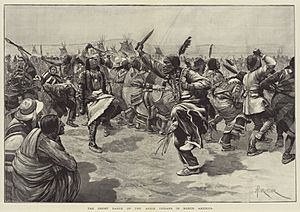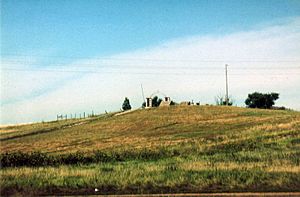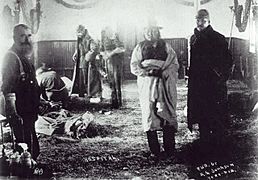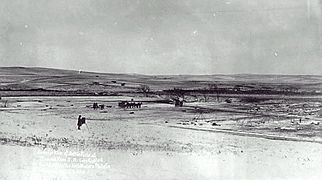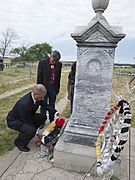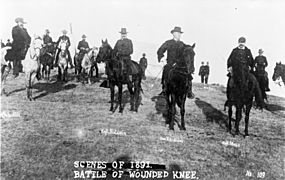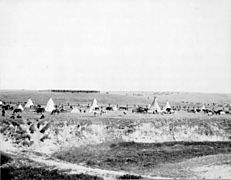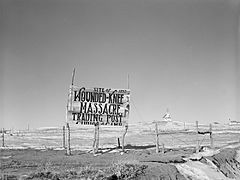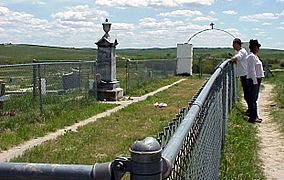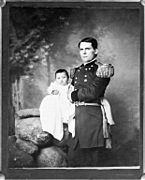Wounded Knee Massacre facts for kids
Quick facts for kids Wounded Knee Massacre |
|||||||
|---|---|---|---|---|---|---|---|
| Part of the Ghost Dance War and the Sioux Wars | |||||||
|
|||||||
| Belligerents | |||||||
| Miniconjou Lakota Hunkpapa Lakota |
|||||||
| Commanders and leaders | |||||||
| Spotted Elk † | |||||||
| Strength | |||||||
| 490 | 120 | ||||||
| Casualties and losses | |||||||
| 31 killed 33 wounded |
90 killed 4 wounded |
||||||
| 200 Native American women and children killed 46 Native American women and children wounded |
|||||||
The Wounded Knee Massacre, also known as the Battle of Wounded Knee, was a massacre of nearly three hundred Lakota people (members of the Sioux nation) by soldiers of the United States Army. It occurred on December 29, 1890, near Wounded Knee Creek on the Lakota Pine Ridge Indian Reservation in the U.S. state of South Dakota. The massacre took place after U.S. soldiers had been sent to move the Lakota to a camp near Wounded Knee Creek and to disarm them. By the time the massacre was over, more than 250 men, women, and children of the Lakota had been killed and 51 were wounded (4 men and 47 women and children, some of whom died later).
Contents
Prelude
For years before the conflict, the U.S. government had continued to take Lakota lands. They broke treaties and called the Native Americans "hostile" for not liking the fact that the government kept taking their land from them. The way of life for the Lakota was being destroyed by the European settlers who were taking the Native American land. The Lakota Sioux could no longer be a nomadic people. They were forced to change the way they found food and clothing because settlers had made bison almost extinct.
During this time, news spread among the reservations of a Paiute prophet named Wovoka, founder of the Ghost Dance religion. Wovoka believed that performing a slow and solemn dance while wearing special shirts called Ghost shirts would bring peace back to the Native Americans. Many of the Great Basin tribes and Plains tribes believed the Ghost Dance brought hope: the white man would soon disappear; the buffalo herds would return; people would be reunited with loved ones who had since passed away; the old way of living before the white man would return.
The ghost dance scared many U.S. settlers, who thought it would lead to violence. The U.S. government decided that they did not like the dance and sent soldiers to stop the Native Americans from dancing by arresting some of the chiefs. The arrest of Sitting Bull at Standing Rock went wrong. He was killed along with some of his people.
Two hundred members of his Hunkpapa band, afraid that they would also be killed, fled Standing Rock to join Chief Spotted Elk (later known as "Big Foot") and his Miniconjou band at the Cheyenne River Indian Reservation. Spotted Elk and his band, along with 38 Hunkpapa, left the Cheyenne River Reservation on December 23 to journey to the Pine Ridge Indian Reservation to seek shelter with Red Cloud. They were intercepted by the army and brought to camp at Wounded Knee Creek. The remainder of the 7th Cavalry Regiment, led by Colonel James W. Forsyth, arrived and surrounded the encampment of Lakota. The regiment had four Hotchkiss mountain guns that they pointed at the encampment.
The Massacre
On the morning of December 29, the U.S. Cavalry troops went into the camp to disarm the Lakota. Nobody knows for sure who started the fight. During the process of disarming the Lakota, a deaf tribesman named Black Coyote did not want to give up his rifle, claiming he had paid a lot for it. At the same time, an old man began performing a ritual called the Ghost Dance. It is thought that Black Coyote's rifle went off at that point and the U.S. Army began shooting at the Indians. Some of the Indians grabbed rifles from the piles of confiscated weapons and opened fire on the soldiers. With no cover, and with many of the Indians unarmed, this lasted a few minutes at most. While the Indian warriors and soldiers were shooting at close range, other soldiers that were surrounding the camp shot the Hotchkiss guns at the camp full of women and children.
The Indian women and children fled the camp, seeking shelter in a nearby ravine. Some of the soldiers killed the wounded. Others jumped onto their horses and chased the Natives (men, women, and children), in some cases for miles across the prairies, and killed many of them as well.
The Aftermath
After a three-day blizzard, the military hired civilians to bury the dead Lakota. The burial party found the dead frozen; they were gathered up and placed in a mass grave on a hill overlooking the encampment. This is where the army had used its Hotchkiss guns to fire on the Lakota. It was reported that four infants were found alive, wrapped in their deceased mothers' shawls.
Forsyth was not held responsible for the massacre and twenty soldiers were given the Congressional Medal of Honor. In June 2019, members of the U.S. House of Representatives introduced the Remove the Stain Act, a bill that would cancel those awards. As of 2023, it has not been passed.
Remembrance
Commemorations of Native American deaths
In 1891, The Ghost Shirt, thought to have been worn by one who died in the massacre, was brought to Glasgow, Scotland. It was displayed in the Kelvingrove Museum until 1998.
In 1903, descendants of those who died in the battle erected a monument at the gravesite. It reads in part: "This monument is erected by surviving relatives and other Ogalala and Cheyenne River Sioux Indians in memory of the Chief Big Foot massacre December 29, 1890. Many innocent women and children who knew no wrong died here."
The Wounded Knee Battlefield was declared a U.S. National Historic Landmark in 1965 and was listed on the U.S. National Register of Historic Places in 1966.
Beginning in 1986, the group named "Big Foot Memorial Riders" was formed. Riders and their horses retrace the path that their family members took to Wounded Knee. They carry a white flag to symbolize their hope for world peace and to honor and remember the victims of the massacre.
Seventh Cavalry Regiment
On July 25, 1893, a monument for members of the regiment killed at Wounded Knee was dedicated. Today, the stone structure still stands near Waters Hall at Fort Riley.
In Popular Culture
Battle or Massacre
The massacre was initially referred to as the "Battle of Wounded Knee." Some Native American groups refer to it as the "Wounded Knee Massacre." The location of the conflict is officially known as the "Wounded Knee Battlefield." The U.S. Army currently refers to it as "Wounded Knee."
Media
Historian Dee Brown wrote a book called Bury My Heart at Wounded Knee. It tells the story of Native Americans in the American West in the late nineteenth century. Other books have been written about the massacre as well, including comic books.
Many songs have been written about Wounded Knee by both Native American artists and other artists.
Movies and video games that use characters from the Wounded Knee Massacre have also been made.
Interesting Facts about the Wounded Knee Massacre
- The Lakota were part of a group of tribes named the Sioux.
- Many Lakota prefer not to be called "Sioux" since it was how their enemies referred to them.
- Chief Sitting Bull was a great leader in the Battle of Little Bighorn.
- Chief Spotted Elk was also called Chief Big Foot.
- Since Wounded Knee, Native American activists have worked hard to show the world that the U.S. government had taken their civil rights.
Gallery
-
US Attorney General Eric Holder laying a wreath at the site of the Wounded Knee Memorial
See also
 In Spanish: Masacre de Wounded Knee para niños
In Spanish: Masacre de Wounded Knee para niños


